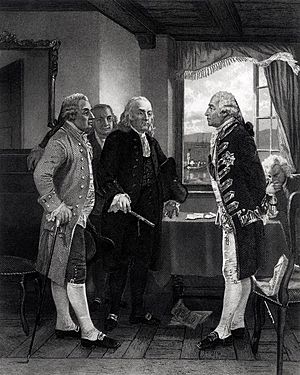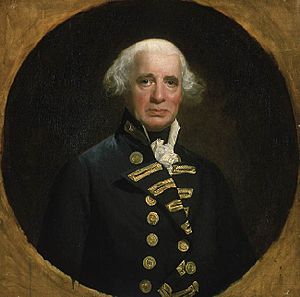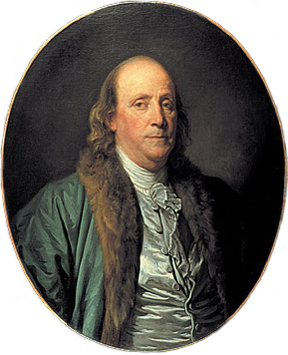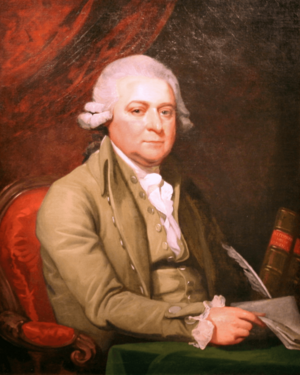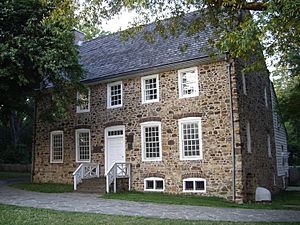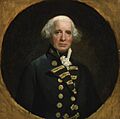Staten Island Peace Conference facts for kids
The Staten Island Peace Conference was a short meeting held on September 11, 1776. It brought together leaders from the British side and the American colonies. They hoped to end the American Revolution quickly. This meeting happened just after the British won the Battle of Long Island. It was also less than three months after the Americans declared their independence.
The conference took place at a house called Billop Manor on Staten Island. This house belonged to a British supporter named Colonel Christopher Billop. The main people at the meeting were British Admiral Lord Richard Howe. From the American side, there were John Adams, Benjamin Franklin, and Edward Rutledge. These three were members of the Second Continental Congress.
Lord Howe wanted to find a peaceful solution. However, his power to negotiate was very limited. The Americans wanted the British to recognize their new independence. Lord Howe could not agree to this. After only three hours, the meeting ended. The British then continued their military plan to take over New York City.
Contents
Why Did the Meeting Happen?
In late 1775 and early 1776, British leaders planned to send a large army to New York City. Admiral Lord Richard Howe and his brother, General William Howe, led this mission. Richard was in charge of the navy, and William led the army. They believed they could still end the fight without more violence. So, they asked for special powers to talk about peace, not just fight.
Admiral Howe had already talked with Benjamin Franklin in 1774 and 1775. But those talks didn't solve anything. General Howe thought the problem of taxes could be fixed. He believed Parliament should still have the main power.
At first, King George III agreed to give the Howes limited powers. But another leader, Lord George Germain, was tougher. He said the Howes should not give in to American demands. This meant they couldn't offer solutions for "taxation without representation" or the "Intolerable Acts".
So, the Howes could only offer pardons to people who stopped fighting. They could not make any big changes. They were told to ask the Americans to break up the Continental Congress. They also had to ask them to bring back their old colonial governments. The Americans also had to agree to Lord North's plan for self-taxation. No deals could be made unless the fighting stopped first.
In July 1776, the British fleet arrived. Admiral Howe tried to talk with General George Washington. He sent letters, but Washington refused them. This was because Howe would not use Washington's title as General. However, Washington did meet with one of Howe's officers. On July 20, Washington learned that the Howes could only offer pardons. Washington replied that Americans had done nothing wrong and didn't need pardons.
Lord Howe then sent a letter to Benjamin Franklin. It offered a truce and pardons. Franklin read the letter to Congress on July 30. He wrote back to Howe, saying that offering pardons to the colonies, who felt wronged, would only make them angrier. Franklin reminded Howe that he once hoped for peace. He also pointed out that the British had burned towns and used foreign soldiers against them.
Planning the Meeting
During the Battle of Long Island on August 27, 1776, the British took over western Long Island. This made Washington move his army to Manhattan. General Howe then paused his attack. The Howe brothers decided to try talking again. They had captured some American officers during the battle. One of them was Major General John Sullivan.
The Howes convinced Sullivan that a meeting with Congress members might help. They released him to deliver a message to Congress in Philadelphia. Sullivan proposed an informal meeting to end the fighting. After Sullivan spoke, John Adams was suspicious. He called Sullivan a "decoy-duck." Adams thought the British were trying to trick them into giving up independence. Others thought it was a way to blame Congress for continuing the war.
Congress decided to send three members to meet Lord Howe. These were John Adams, Benjamin Franklin, and Edward Rutledge. Their job was only "to ask a few Questions and take [Howe's] Answers." They had no power to make deals. When Howe learned this, he almost canceled the meeting. But after talking with his brother, he decided to go ahead. None of the American delegates believed the meeting would achieve anything.
Lord Howe first wanted to meet the Americans as private citizens. This was because British policy did not see Congress as a real government. But for the meeting to happen, he agreed to recognize them as official representatives of Congress.
The Meeting on Staten Island
The meeting took place at Christopher Billop's house on Staten Island. British soldiers had been using the house, and it was very dirty. But one room was cleaned for the meeting. As a safety measure, a British officer stayed with the Americans as a hostage during the talks. However, the American delegates invited him to come along to the meeting.
When they arrived, the American delegates walked past German soldiers working for the British. They went into the house. According to Adams, they were served wine, ham, mutton, and tongue.
The meeting lasted three hours. But both sides could not agree on anything important. The Americans said that any talks needed the British to recognize their new independence. Lord Howe said he did not have the power to do that. Edward Rutledge asked Howe if he could cancel the Prohibitory Act. This act allowed the British navy to block American ports. Howe said Sullivan was wrong and he couldn't cancel it. Howe's power only allowed him to stop the act if the colonies agreed to pay fixed amounts of money instead of taxes. But none of this could happen unless the Americans stopped fighting first.
For most of the meeting, everyone was polite. Lord Howe said he would feel America's loss "like the loss of a brother." Franklin replied that they would do their best to prevent Howe from feeling that sadness.
Lord Howe sadly stated that he could only see the American delegates as British subjects. Adams quickly replied, "Your lordship may consider me in what light you please,... except that of a British subject." Lord Howe then looked past Adams to Franklin and Rutledge and said, "Mr. Adams appears to be a decided character."
What Happened Next?
The Congressmen went back to Philadelphia. They reported that Lord Howe "has no propositions to make us." They also said that "America is to expect nothing but total unconditional submission." John Adams later found out that his name was on a list of people who would never be pardoned by the Howes. Congress published the report without adding any comments.
Because Lord Howe did not publish his own report, many people saw the meeting's failure as a sign that the British were weak. But many British supporters and some British observers thought the American report was not completely true.
One British writer said about the meeting: "They met, they talked, they parted. And now nothing remains but to fight it out." Lord Howe told his brother that the conference failed. Both brothers then got ready to continue their fight for New York City. Four days after the meeting, British troops landed on Manhattan and took over New York City.
The house where the conference happened is now a museum. It is part of Conference House Park. It is a very important historical site.
Images for kids
See also
 In Spanish: Conferencia de paz de Staten Island para niños
In Spanish: Conferencia de paz de Staten Island para niños


